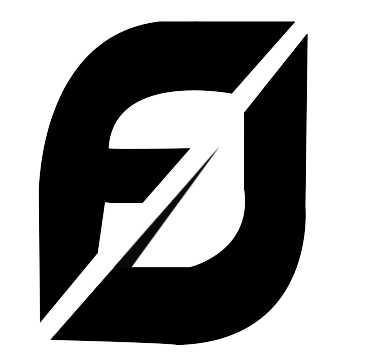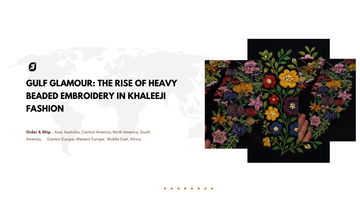اللمعان الخليجي: صعود الأقمشة المطرزة بالخرز في عالم الموضة
On a recent evening in Dubai, Noor Al-Sabah steps into a family gathering wearing a flowing black abaya. But this is not the plain garment of her grandmother’s generation. Noor’s abaya shimmers under the chandelier light, its surface alive with intricate beadwork, pearls stitched by hand, and sequins that catch the eye at every turn.
Her cousins rush to take photographs. On Instagram, Noor tags the boutique she bought it from — an account with thousands of followers curating the latest in Gulf fashion. Within hours, her look is shared across WhatsApp groups and highlighted on Khaleeji fashion” hashtags.
This is the new face of Gulf style: heavy beaded embroidery that merges tradition with a striking modern glamour.
The evolution of Khaleeji elegance
The abaya, kaftan, and farasha have long been central to Gulf women’s wardrobes. Historically, they were defined by modest silhouettes and subtle handwork — fine embroidery, delicate trims, and understated embellishments. But in the past decade, tastes have shifted dramatically.
Today, Gulf fashion is less about understatement and more about statement. Elaborate embroidery, dazzling beadwork, and hand-finished sequins are increasingly common. For weddings, Eid, and high-profile social events, women in the Gulf are choosing garments that radiate luxury.
Designer Fabric Wholesale Supplier in Surat for Boutiques & Exporters
As a leading designer fabric wholesale supplier in Surat, we cater to boutiques, exporters, and retailers across India. Our extensive collection features embroidered, printed, and woven fabrics perfect for global fashion markets. From traditional Indian wear to contemporary international designs, we supply bulk quantities to businesses in all 28 states and 9 union territories. With export-quality standards and competitive pricing, we're the preferred partner for boutiques seeking unique collections and exporters targeting international markets. Experience Surat's finest textiles with pan-India delivery.
Designers from Saudi Arabia, the UAE, Qatar, and Oman have embraced this transformation. Their creations combine traditional cuts with global couture trends: metallic threading, gemstone appliqué, shimmering sequins, and layered textures of beads and pearls. The results are garments that feel both rooted in heritage and undeniably contemporary.
Intricate threads & premium texture Printed Fabric
Creative, colorful & always trending Position Printed Fabric
Perfect alignment for standout looks Jacquard Fabric
Rich textures with woven luxury Plain Dyeable (RFD)
Customize colors, your way Pure Dyed Fabrics
Ready-to-stitch brilliance Designer Dupattas
From shimmer to sheer elegance Ready Stocks
Quick ship fabrics in bulk Kurti Fabrics
Comfort meets tradition New Arrivals
Fresh drops, every week
Why beads and sequins matter
For many Gulf women, heavy beaded embroidery is more than just a style choice. It signals social status, cultural pride, and individuality.
“Every stitch has meaning,” says an Emirati designer who caters to elite clients in Abu Dhabi. “When you wear hand-beaded embroidery, you’re not just wearing fashion — you’re wearing art.”
The appeal lies partly in craftsmanship. Hand-sewn beads and sequins take hours — sometimes weeks — to complete. The weight of a garment itself can feel luxurious, the shimmer reflecting wealth and taste. At the same time, beads allow designers to experiment with patterns that embroidery threads alone cannot achieve: three-dimensional flowers, mirror-inlaid motifs, and radiant geometrics that sparkle under light.
The roots in South Asian artistry
The Gulf’s love affair with heavy beaded embroidery did not emerge in isolation. It draws deeply from South Asian textile traditions — particularly Indian and Pakistani crafts like zardozi, aari, and shisha (mirror) work.
Zardozi embroidery, which flourished under Mughal patronage, employs gold and silver threads combined with beads, pearls, and sequins. Aari work uses a hooked needle to create fine, chain-stitch patterns that allow dense beading with speed and precision. Mirror work, popular in Gujarat and Rajasthan, incorporates small reflective discs into embroidery, producing a kaleidoscopic effect.
Wedding Collection Fabric Manufacturer & Exporter in Surat
Create stunning wedding collections with our premium fabrics from Surat. As a manufacturer and exporter, we specialize in bridal lehengas, sherwani fabrics, and ceremonial wear materials that meet international standards. Our collection includes heavy embroidered nets, luxurious velvets, traditional silks, and contemporary blends. Serving domestic clients across all Indian states and international buyers worldwide, we bridge Surat's craftsmanship with global fashion trends. From local boutiques to international exporters, we deliver excellence in every fabric roll.
Over centuries, traders and artisans carried these techniques across the Arabian Sea into the Gulf. Today, many Khaleeji designers employ South Asian artisans in their workshops, blending regional silhouettes with Indian craftsmanship. The result: garments that feel both local and transnational, embodying centuries of cultural exchange.
Instagram and the digital runway
Much of the recent boom in beaded Gulf fashion is driven by social media. Instagram pages such as poshaki_ronaki showcase abayas and gowns glistening with sequins, pearls, and stones. These posts attract tens of thousands of views and inspire women across the region to commission similar designs.
Hashtags like #BeadedAbaya, #KhaleejiFashion, and #ArabianLuxury are filled with influencers and brides flaunting custom-made ensembles. What was once limited to exclusive boutiques in Riyadh or Dubai is now accessible online. Women can browse global trends, DM a designer, and place a custom order — often receiving their outfit within weeks.
Social media has also blurred borders. A bride in Muscat might source her wedding gown from a boutique in Mumbai, while a designer in Jeddah might commission beadwork from artisans in Karachi. This digital economy is reshaping the Gulf’s fashion ecosystem.
The business of beads
The rise of heavy beaded embroidery is not only cultural but economic. The demand for labor-intensive garments has created opportunities for artisans, suppliers, and exporters across Asia and the Middle East.
Suppliers such as fabricdiary.com have tapped into this demand by offering bulk and customized embroidered fabrics online. Boutiques, garment manufacturers, and even individual designers can order premium fabrics, select thread colors, specify sequin patterns, and receive material ready for tailoring.
This business model bridges two worlds: the heritage of handcrafted embroidery and the efficiency of modern e-commerce. For Gulf buyers, it means exclusivity and customization at scale. For South Asian artisans, it ensures steady demand for their skills.
Luxury, but at a cost
Yet the glitter has its shadows. Heavy beadwork is labor-intensive, often relying on underpaid artisans working long hours. In some South Asian workshops, women and children contribute to embroidery production for low wages.
There is also an environmental cost. Sequins and beads are typically made of plastic or synthetic materials that are non-biodegradable. The fast fashion cycle — producing, wearing, and discarding garments quickly — raises concerns about sustainability.
Embroidery Fabric Wholesaler in Surat for Retailers & Designers
Source the finest embroidery fabrics from our Surat wholesale unit, serving retailers and designers nationwide. We offer sequins, mirror work, thread embroidery, and zari work on various base fabrics. Whether you're a boutique owner in Mumbai, a designer in Delhi, or a retailer in Kolkata, our pan-India network ensures timely delivery. With minimum order quantities suitable for small and large businesses, we empower fashion entrepreneurs across all 884 districts. Join India's creative community with our Surat-made embroidery fabrics.
Some Gulf designers are beginning to address these issues by sourcing eco-friendly beads, using recycled sequins, and highlighting fair-trade practices. But the industry overall remains a long way from sustainability.
A marker of cultural pride
Despite these challenges, heavy beaded embroidery retains its cultural significance. In a region where women’s fashion is both personal and political, choosing a heavily embellished abaya or gown can be a statement of pride.
“When I wear beaded designs, I feel connected to my heritage, but also confident that I belong to the modern world,” says Mariam, a 27-year-old Qatari student. “It’s like carrying history on my shoulders — but with sparkle.”
For Gulf women, embroidery is not simply decoration. It is identity, heritage, and aspiration sewn into fabric. Beads transform garments into canvases of cultural storytelling.
Global recognition
High-fashion houses have taken note. At Paris Fashion Week, couture designers showcased gowns rich in beadwork — some produced in Indian ateliers long used by luxury brands like Dior and Chanel. The so-called “Ibiza aesthetic,” characterized by maximalist beadwork and sequins, is in fact deeply indebted to South Asian and Middle Eastern traditions.
As global audiences celebrate beadwork on runways, Gulf designers are reclaiming its narrative. By integrating traditional embroidery into contemporary abayas and gowns, they assert ownership of a craft long exported to Western couture.
The future of Gulf beadwork
Looking ahead, the future of Gulf fashion seems set to sparkle even brighter. Hybrid production models — machine embroidery for base designs, sequins applied selectively, and final hand-beaded finishing — offer cost-effective ways to achieve high-end looks.
Online platforms will continue to democratize access. Whether it is a bride in Kuwait commissioning a custom gown or a boutique in Canada ordering wholesale embroidered fabric, the market is expanding globally.
At the same time, conversations about sustainability and fair wages will push designers to innovate. The Gulf’s fashion scene has the potential not just to showcase glamour, but also to lead in ethical and eco-friendly practices.
More than fashion
Heavy beaded embroidery in the Gulf is more than a passing trend. It is a cultural renaissance that ties the past to the present, the local to the global. It reflects the aspirations of Gulf women, the artistry of South Asian artisans, and the possibilities of modern commerce.
From Instagram feeds to wedding halls, from artisan workshops to online suppliers like fabricdiary.com, the story of Gulf beadwork is still being stitched — bead by bead, sequin by sequin, into the fabric of modern identity.
As Noor’s abaya sparkled that evening in Dubai, it carried with it centuries of history and a glimpse of the future. And that, perhaps, is the true power of fashion: not just to adorn, but to tell stories that endure.
_________________________________________
FAQ
س1: ما الذي يميز الأقمشة المطرزة بالخرز في الخليج؟
ج: تجمع بين التراث الخليجي والفخامة العصرية باستخدام الخرز واللؤلؤ والترتر لتصميم قطع فريدة.
س2: هل يمكنني طلب تصميم مخصص من FabricDiary؟
ج: نعم، يوفر FabricDiary خدمة التخصيص حسب الألوان، الخيوط، وأنماط التطريز لتلبية احتياجات المصممين والبوتيكات.
س3: هل هذه الأقمشة مناسبة للمناسبات الخاصة مثل الأعراس والأعياد؟
ج: بالتأكيد، فهي الخيار المثالي للعبايات، القفاطين، وفساتين المناسبات الفاخرة.
س4: هل يمكن شراء الأقمشة المطرزة بالخرز بالجملة؟
ج: نعم، FabricDiary يقدم خيارات شراء بالجملة للمصنعين والموردين وأصحاب المحلات.
س5: كيف يتم تنفيذ التطريز بالخرز؟
ج: يتم الدمج بين التطريز الآلي الأساسي ثم الإنهاء اليدوي بالخرز واللؤلؤ والمرايا الصغيرة لإعطاء لمسة فاخرة.
س6: هل تتوفر شحنات إلى دول الخليج والعالم؟
ج: نعم، يتم توفير الشحن إلى جميع دول الخليج إضافة إلى أسواق عالمية مثل أوروبا وأمريكا.
س7: هل يمكن دمج الخرز مع أنواع أخرى من التطريز؟
ج: نعم، يتم دمج الخرز مع التطريز بالخيوط، الزري (الزردوزي)، أو الترتر لإنتاج تصاميم متكاملة وفاخرة.






